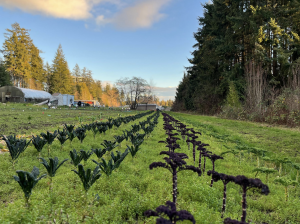3461 Ross Drive; University Endowment Lands

The UBC Farm is located on the unceded ancestral territory of the hən̓q̓əmin̓əm̓-speaking xʷməθkʷəy̓əm (Musqueam) people. Farmland has been a part of UBC’s Vancouver campus since the establishment of the university site on Point Grey. However, the farm’s size, location, purpose, and operations have all seen many changes since the first clearing for agriculture began in 1915. Situated within a 90-year-old coastal hemlock forest, the Farm features cultivated annual crop fields, perennial hedgerows and orchards, pasture, teaching gardens, and forest stands.
The above text is taken from the UBC Farm’s official website, a compressed history of the layered and contested stories that the land shows hints of. In addition, we are barely told about the Four Indigenous initiatives that run autonomously at the site, The Musqueam Garden, the Culturally Relevant Urban Wellness Program (CRUW), a project started in 2001 by the Vancouver Aboriginal Child and Family Services Society, Tal A’xin: Maya in Exile Garden, which is one of the longest running community projects that the farm hosts, which started in 2001, and xʷc̓ic̓əsəm: Indigenous Health Research & Education Garden, which is guided by the principle that ‘food is medicine’ and follows the research ethic framework of the “4R’s: respect, relevance, reciprocity, and responsibility” and a holistic understanding of health and healing.
The Farm is highlighted as a project of sustainable food production, and part of the Centre for Sustainable Food Systems, a program at the University that states that it is engaging in research and edication about global and local food systems in connection to sustainability and adaptation with climate change. The financial ties to the RBC Bank are mentioned as a positive support, while the Bank is actively invested in several fossil fuel, mining, and other extractive projects that run counter to sustainability and climate justice.
Read more about the complexities of this space.